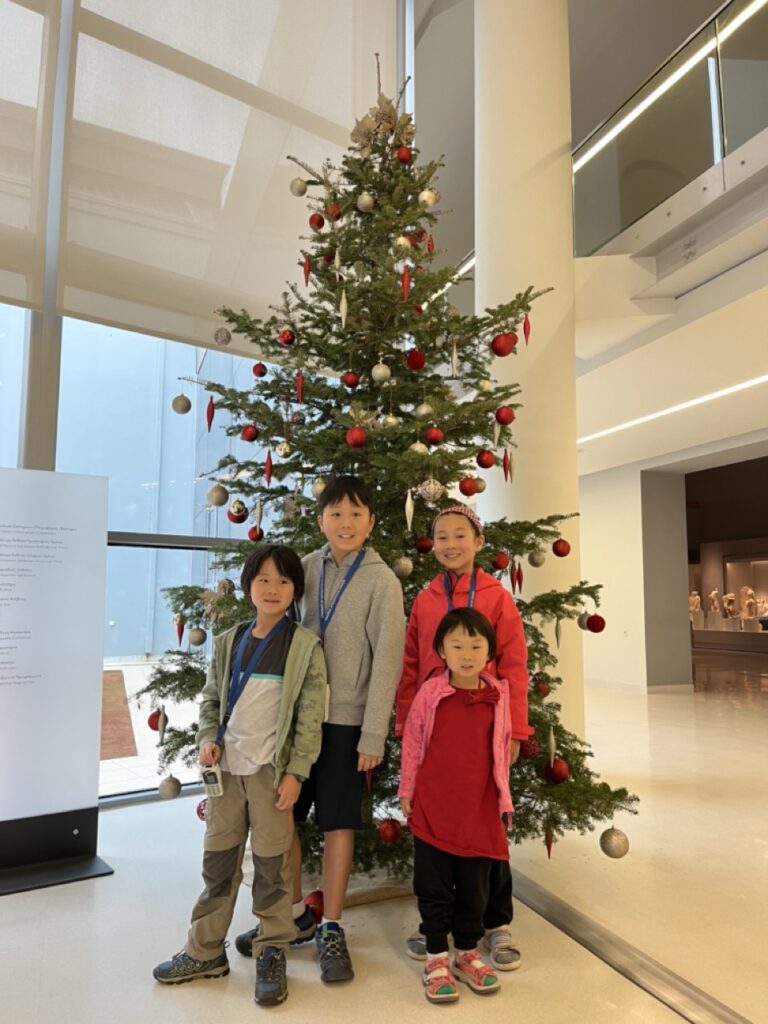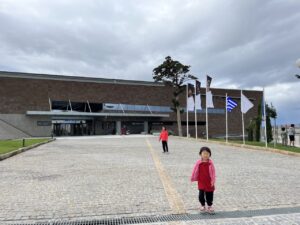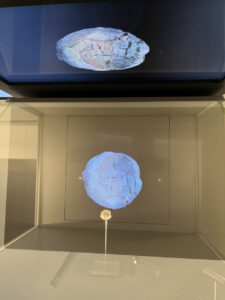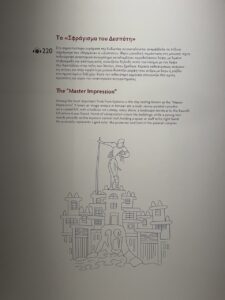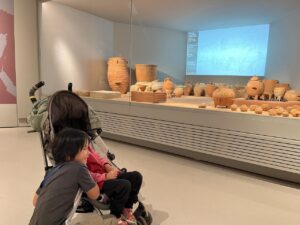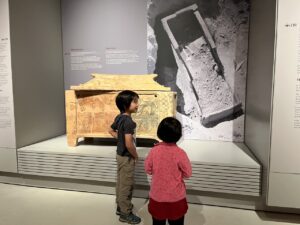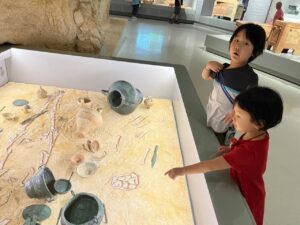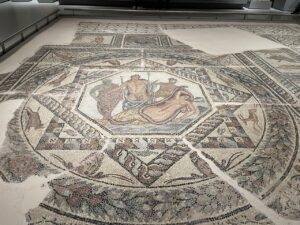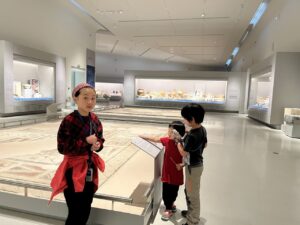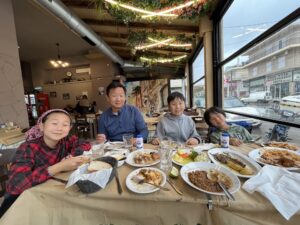It was forecast to be a rainy day so we planned to spend time indoors at the Archaeological Museum of Chania. The museum is completely new and modern. It was recently opened in 2022 at its current location in Chalepa, after being relocated from its original location in the Monastery of Agios Fragkiskos, the largest Venetian church in Chania. We were greeted at the entrance by a real Christmas tree beautifully hung with red and silver decorations.
The museum is expertly curated with excellent descriptions and information. There are a number of exhibits where technology, in the form of interactive displays and digital media, is used to tell the story of the Minoans. Free devices for self-guided audio tours were available, which allowed the kids to tour the museum at their own pace. The museum staff also gifted the children scavenger hunt pamphlets made just for kids to search for specific artifacts and information. The museum is not large, occupying only three galleries on the ground floor and one room upstairs.
The museum is organized along a rough chronological timeline to represent the civilizations that have thrived and met their demise in and around Chania, starting from around the 10th century BC up to the Roman occupation ending around the 3rd century AD.
The story of prehistoric Chania begins in the first gallery of the permanent exhibition with ancient objects from the earliest human presence in Chania. The story continues with artifacts from prehistoric settlements, showing the exquisite artistry of the Minoan communities in West Crete.
The second gallery continues the story with the development of thriving city-states in West Crete, including Kydonia. There was an in-depth exhibit on seals that Minoans used as a sort of identification or signature for the owner. The most impressive seal that was displayed with a magnifying effect through a hologram is called “The Master Impression”. The seal itself was small, tiny enough to fit on a ring but the details of the engraved image were surprisingly detailed and precise. Archaeologists consider it one of the most important artifacts left behind by the Minoans. The seal depicts a building complex with multiple stories, possibly a Minoan palace or city. The male figure, possibly a king, prince or a god, in the image has long hair and holds a scepter or spear.
In the third gallery, everyday artifacts are on display. The most fascinating parts happened to be the most morbid exhibits revolving around death. There were replicas of burial coffins (larnakes) in various shapes and materials. The kids particularly enjoyed the reconstruction of a Minoan home that was destroyed in the great earthquake of 365 AD that devastated the entire island. This was accompanied by a video enacting the destruction of the “Miser’s House”. EY was captivated by the video and watched it several times from beginning to end, with follow up questions to clarify certain parts of the story. The video told the story of a couple who had hidden their coins in various places throughout their home. When the earthquake of 365 AD hit, they ran downstairs to gather their valuables that were hidden in the basement. Before they were able to escape with their wealth intact, they were crushed inside their collapsing home. When the site was excavated, the couple was found in close proximity to three clay pots filled with coins. Also nearby was a cooking pot with remains of cooked seafood inside.
In the final gallery, we stopped to admire a Roman floor mosaic depicting Dionysus and Ariadne. The mosaic dates back to the 3rd century AD and was discovered near the market square of Chania in 1977. Ariadne is a mythological Minoan princess who helped Theseus escape from the labrynth. She eventually married Dionysus, Roman god of wine and parties. In the scene depicted on the mosaic Dionysus is flanked by two satyrs and has just found Ariadne asleep on the island of Naxos after she was abandoned by Theseus.
When we were finished with our visit to the museum, the rain was pouring from the sky in buckets. We waited on the second floor for a while, watching the rain come down and searching for a break in the rain so we could get to the car without getting soaked.
After a while, we accepted that the torrential rain was not letting up anytime soon. Leo volunteered to dash to the car to get our raincoats. He did better than that and like a knight atop a white steed, he appeared in moments at the front door of the museum with our white Mercedes van.
Through the heavy downpour, we drove to a small taverna well known for local food. The owner recommended a few dishes like the octopus stew, grilled pork and potatoes, chicken stewed with tomatoes served with pasta. We couldn’t resist also ordering the pastischio, steamed veggies and I maybe because of the rainy weather, was craving the lentil stew served with feta and onions. As the rain continued to fall outside, we were sheltered and warm inside the taverna, indulging in the hearty and delicious local food.
Author
-

Song is the mother of four children. She and her family have stepped away from it all and in September 2023, began traveling the world while homeschooling. Song is an ABC (American born Chinese) and has an undergraduate degree from Cornell and an MBA from Harvard. She is an entrepreneur and an educator. Her hobbies include learning, traveling, reading, cooking and baking, and being with children.

